Ammonia poisoning is one of the most common health issues in betta fish. It is usually caused by poor water quality or overcrowding.
In this article, I will discuss identifying when your betta has ammonia poisoning and what to do if it happens.
Prompt treatment is crucial if you think your betta has ammonia poisoning. Your betta’s condition could worsen very fast.
We’ll also examine ways to prevent ammonia spikes from occurring, so your betta can stay healthy for many years ahead.

Table of Contents
Causes of Betta Fish Ammonia Poisoning
Ammonia poisoning is a common problem for fish tanks. It occurs when the nitrogen cycle in a tank becomes disrupted, creating toxic levels of ammonia buildup.
Detectable levels of ammonia are dangerous for betta fish.
Excess ammonia comes from accumulations of fish waste, uneaten food, and dead plant material. If you do not remove these substances, they cause an imbalance in the water’s chemistry.
A nitrogen cycle crash can cause diseases for all inhabitants of the tank. High levels of toxic substances may be deadly.
Overfeeding and overcrowding also contribute to excessive amounts of ammonia in a tank. Excess food and too many fish means more waste, which can overload your aquarium filtration.
You must support the nitrogen cycling process with a sound filter system and a regular cleaning schedule.
Performing weekly water changes helps reduce ammonia levels by providing bacteria colonies with fresh oxygenated water.
Oxygen is essential for these beneficial colonies to break down toxins like ammonia into harmless nitrates.
Always treat fresh tap water with a dechlorinator before adding it to your betta tank.
Ensure the dechlorinator removes chloramine as well as chlorine. This prevents the chlorine compounds in some tap water from releasing ammonia.
Symptoms of Ammonia Poisoning in Bettas

Gasping at the surface is a sure sign of ammonia poisoning in betta fish.
You may also notice discoloration and spots on your betta’s body.
As the condition progresses, your betta also becomes lethargic and may stop eating.
Recognizing these signs and taking swift action is key to preventing further damage to your betta’s health.
Extreme or long-term ammonia poisoning may be fatal to your betta.
Lethargy and Loss of Appetite
It may be a sign of ammonia poisoning if you notice your betta’s usual enthusiasm waning.
Your fish may lack the energy to swim around its tank or interact with its environment due to the higher levels of toxins in the water.
Ammonia poisoning may also lead to a decreased appetite, which should not go unnoticed.
Loss of appetite can cause malnutrition and a weakened immune system. This makes it more difficult for your betta to recover from ammonia poisoning.
Gasping At The Surface
One of the most common symptoms of ammonia poisoning in betta fish is gasping at the tank’s surface.
This behavior results from a buildup of toxic ammonia levels that irritate and damage a betta’s delicate gills. The betta will gasp for oxygen as if it was suffocating.
If you notice your betta exhibiting these behaviors, immediately test your tank’s water for ammonia.
Check out these other reasons your betta fish is hanging around the filter and top of the tank.
Discoloration and Spots
If you see red streaks on your betta’s body, it’s likely a sign of ammonia poisoning. White spots may also form around the fins and gills.
Ammonia is a corrosive substance and can cause burns to the protective layers of the betta’s scales and fins. This damage may lead to infection and discoloration.
You must treat secondary infections from ammonia poisoning with antibiotic medication.
A betta’s bright colors may also turn pale due to the stress from high ammonia levels. The fish may also develop dark stress stripes.
Red or Inflamed Gills
Ammonia irritates a betta’s gills, causing inflammation and redness.
Your betta’s gills may appear red or purple.
Severe cases of ammonia poisoning may also cause bleeding gills. Take action right away if you notice this symptom.
Testing Your Betta’s Water for Ammonia
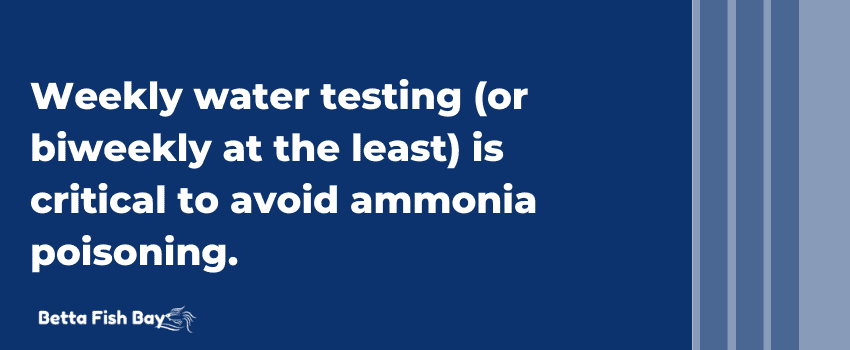
Testing tank water regularly is essential to maintaining the health of your betta fish.
Ammonia poisoning can harm and even kill your beloved pet quickly. It is essential to check ammonia levels with an appropriate test kit.
Filtration systems are also helpful in keeping these levels low and safe. But you must check them regularly, too.
Any ammonia level higher than 0 ppm (parts per million) is dangerous for bettas.
Using liquid test kits or strips to check ammonia levels and other water parameters. Both provide precise results and allow you to make necessary changes before things get out of hand.
Consistent testing and proper filtration maintenance ensure your betta lives in a healthy environment.
Preventing Betta Ammonia Poisoning
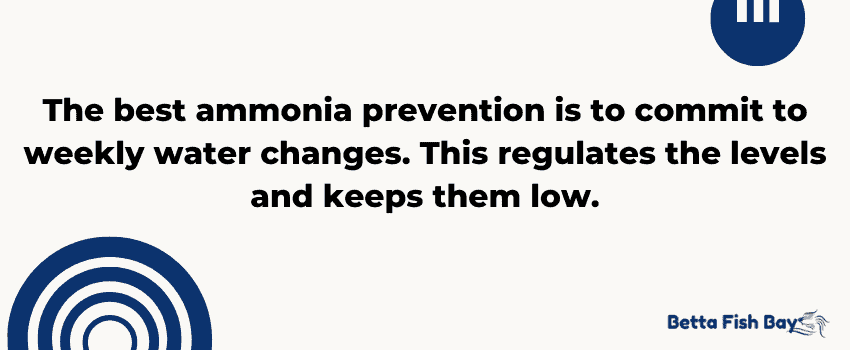
We all know how important it is to maintain tank cycling and avoid overcrowding to prevent betta fish ammonia poisoning. Let’s discuss how we can do this effectively.
Maintaining Tank Cycling
Maintaining tank cycling is essential for preventing betta ammonia poisoning.
Nitrification establishes nitrifying bacteria colonies in the aquarium environment. These bacteria convert biological waste into less toxic compounds. You must manage your nitrogen cycle properly to keep fish healthy.
To ensure a successful cycle, checking pH levels regularly and adjusting as necessary is crucial. Use dechlorinated water, provide adequate filtration, and avoid overcrowding your tank.
Keeping these factors in balance will help create an optimal environment for your fish.
Avoiding Overcrowding
Overcrowding your tank is a surefire way to cause ammonia poisoning in bettas, as it can quickly lead to dangerous levels of waste and toxins.
To avoid this, do not exceed the recommended number of fish for your tank’s size.
Also, ensure you have an appropriate filter system. Use a filter designed for the specific size of your aquarium.
Most betta fish community tanks are 20 gallons or larger, depending on the species of the tank mates.
A larger tank helps keep ammonia levels low by providing beneficial bacteria with more surface area. This gives the bacteria more space to colonize and effectively break down pollutants.
By keeping these two factors in check, you’re well on your way to creating a safe environment for your fish!
Weekly Water Changes
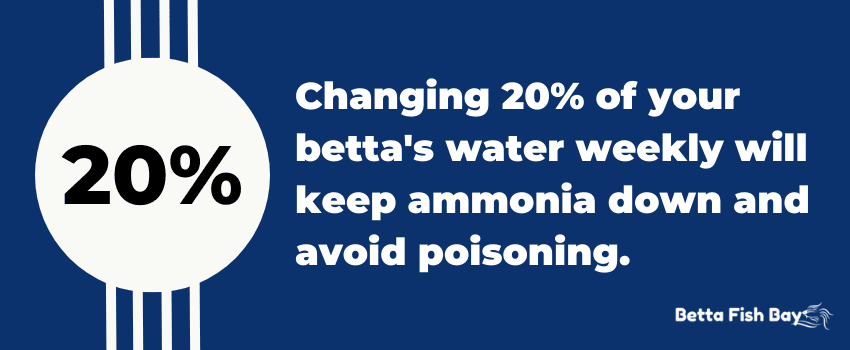
Partial water changes every week are necessary to maintain safe water parameters.
Remove up to 20% of the tank water and replace it with fresh water treated with a dechlorinator.
While performing the water change, use the siphon hose on the gravel vacuum to remove debris from the substrate.
Avoiding Overfeeding
Overfeeding your betta contributes to ammonia buildup as the leftover food decays.
A betta’s stomach is about the same size as its eyes.
Feeding your betta smaller meals prevents food waste. It also prevents other issues like bloating and constipation.
Aim for 2-4 pellets twice daily, spaced about 6-8 hours apart. This gives your betta time to properly digest each meal between feeding times.
Treating Betta Ammonia Poisoning
There are several ways to combat the effects of ammonia poisoning in your betta fish.
A partial water change removes excess ammonia from your betta tank.
Cycling and filtering your aquarium water is vital to keeping your betta healthy.
It is also important to remove uneaten food so it does not break down and contaminate the tank.
Administering treatments to your betta is the last step to aid in its recovery. Read our post here with additional tips on removing ammonia from your fish tank.
Perform a Partial Water Change
When treating betta fish ammonia poisoning, performing a partial water change is essential.
It’s best to do this immediately and ensure the aquarium water you use for replacement is free of chlorine or other harmful compounds.
Never skip this step, as it helps reduce the toxic ammonia levels in the tank. This gives your betta a fighting chance against the deadly poison.
Do not remove over 20% of your tank water at one time. Removing too much water may crash your nitrogen cycle.
Test the water after each water change to ensure ammonia levels are lowered.
You may also consider replacing some or all of the filter media during this time. This helps the filter remove toxins more effectively from the water column.
Rinsing your filter media in tank water avoids destroying any beneficial bacteria.
Cycle and Filter Your Aquarium Water
Once you’ve done a partial water change and reduced the amount of toxic ammonia, it’s time to look at your tank cycling and filtration.
It’s important to ensure these are running correctly so your betta can access clean, safe water.
The nitrogen cycle converts ammonia into nitrite. Nitrite is then converted to its less toxic form, nitrate.
Weekly partial water changes help maintain a healthy nitrogen cycle.
If your filter media gets clogged, it cannot effectively do its job. Check if it needs cleaning more frequently.
Doing this will help keep levels of harmful toxins low. This ensures your betta gets all the oxygen they need in its environment.
Remember, when treating betta ammonia poisoning, good filtration and cycling are key for recovery!
Remove Uneaten Food
Once you’ve sorted your aquarium cycling and filtration, it’s time to tackle another potential source of ammonia – excess food.
Uneaten fish food in the tank can decay and release toxins into the water. Make sure you remove any leftover pellets or flakes after feeding.
It’s also important to watch for other decaying matter, such as dead plants or leaves. Decaying organic matter is a common source of extra ammonia in a fish tank.
Taking action now will help prevent further toxin build-up and put your betta on the path to recovery!
Administer Treatments
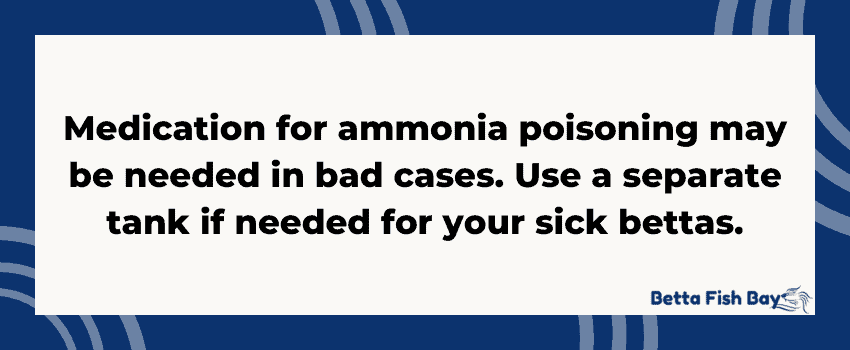
You have taken care of the aquarium cycling and filtration and removed uneaten food and other sources of ammonia. Now, it’s time to consider administering medications.
Depending on the severity of the poisoning, your vet may recommend an ammonia remover or other treatments designed explicitly for betta fish.
Medications can help reduce toxins in the tank and get your betta back on track with its recovery. But make sure to follow all instructions carefully when treating your betta.
Don’t forget to keep a close eye on things too. More drastic measures may be necessary if symptoms do not improve after treatment.
If your betta has suffered ammonia burns, antibiotic treatment is necessary.
Your betta may develop black patches on its body as the ammonia burns heal.
Administer antibiotic treatments to your betta in a separate quarantine tank. Antibiotic medications may kill beneficial bacteria in your main tank.
Recovery Time
The recovery time for ammonia poisoning in betta fish depends on several factors. The severity of the poisoning and the overall health of the fish play a big role in how quickly they can recover.
If caught early, a betta can bounce back with proper care within a week or two. But if left untreated, the damage caused by high ammonia levels in the tank water could take months to heal.
Staying on top of water changes and providing the correct medications can speed up recovery.
Long-Term Effects
Having discussed the recovery time of betta fish after an ammonia toxicity episode, it is important to consider the long-term effects.
Beneficial bacteria colonies maintain healthy levels of ammonia in a betta’s environment. When these colonies become damaged by high ammonia concentrations, they can take weeks or even months to regrow.
If there have been several ammonia poisoning episodes, it will take longer for beneficial bacteria to remove all traces of excess ammonia from the water.
Repeated exposure to high ammonia levels can cause lasting damage to the immune system of bettas. This leaves them more vulnerable to other illnesses.
Prevent this by ensuring your betta’s tank remains free from toxic substances like ammonia.
Regular water changes are necessary to keep toxin levels low and provide optimal living conditions for your betta fish.
Other Water Parameters To Monitor
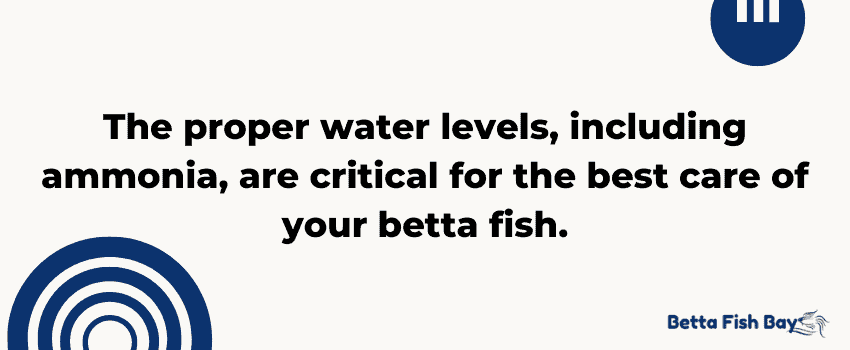
Besides ammonia, you must also monitor other water parameters, such as:
- Nitrite
- Nitrate
- pH levels
- Temperature
Sudden changes in these water parameters can affect your betta’s health.
Use an aquarium testing kit to check your water parameters regularly. Weekly water changes and cleaning maintains healthy water conditions.
A reliable thermometer helps you keep track of water temperatures.
Nitrite
Bacteria release nitrite as a byproduct during the breakdown process of ammonia.
The presence of nitrite means beneficial bacteria are present and actively breaking down waste into less toxic forms. But, high nitrite concentrations can still lead to ill health or even death in betta fish.
Like ammonia, nitrite levels in your aquarium should not exceed 0 ppm.
Nitrate
Nitrate is less harmful than ammonia or nitrite. But you must still ensure nitrate levels in your betta tank are not too high.
Acceptable levels of nitrate in your betta tank are 40 ppm or less.
Live aquarium plants act as natural filters and consume nitrate from the water.
Beneficial bacterial colonies also lower nitrate levels by converting them into nitrogen gas.
Ph Levels
Another factor in your betta’s water parameters is the pH level. The ideal pH level for betta fish ranges between 6.5 and 7.5.
Keep pH levels in the optimal range with weekly water changes.
You may raise pH levels by adding crushed corals or an air stone.
Lower pH levels with peat moss, driftwood, or Indian almond leaves.
Always make changes to your water’s pH slowly. This avoids causing shock in your betta.
Temperatures
Bettas are tropical fish, and they thrive in warmer water temperatures.
Optimal temperatures for betta fish range from 78-80° degrees Fahrenheit (25.5-27° C).
A quality aquarium heater helps maintain these warm temperatures.
When the temperature is too low, it lowers your betta’s metabolism and slows digestion. Extremely high temperatures overheat your betta and increase the toxicity of ammonia.
Sudden temperature fluctuations also cause temperature shock in bettas.
Use an aquarium thermometer and check water temperatures regularly.
Final Thoughts on Ammonia Poisoning in Bettas
By understanding the causes of ammonia poisoning and taking steps to prevent it, we can help keep our betta friends healthy and happy for longer.
Monitoring the water parameters in your betta tank and sticking to a regular cleaning schedule helps you avoid serious issues with ammonia toxicity.
Prevention is always better than treatment when protecting your beloved betta from harm.
With proper monitoring and care, your betta can live a full life free from the threat of ammonia poisoning.
For more on setting up your betta tank, check out our complete guide at the link.


